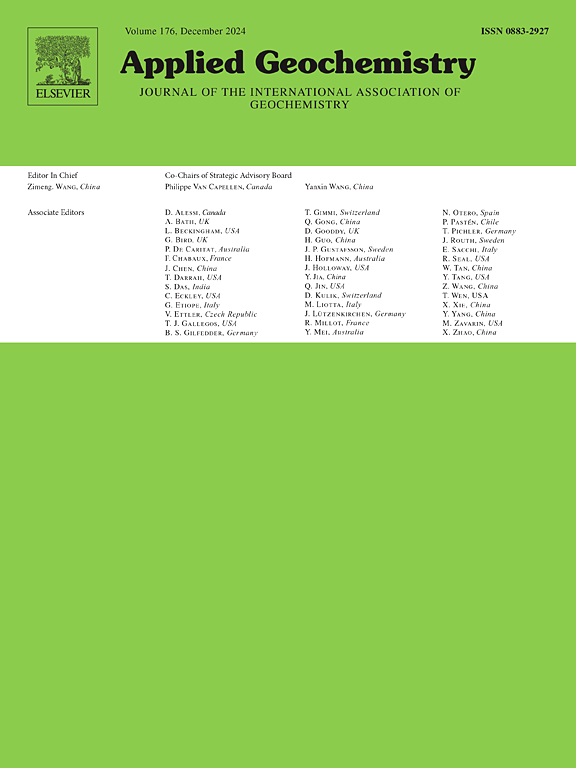Intermediate oxidation products from pyrrhotite grains in natural waste rock: A synchrotron study using Fe K-edge XANES
IF 3.4
3区 地球科学
Q1 GEOCHEMISTRY & GEOPHYSICS
引用次数: 0
Abstract
Sulfide mineral oxidation releases acidity, sulfate, iron and trace element impurities to the environment. Iron K-edge X-ray absorption near edge spectra (XANES) were collected across transects of partially oxidized pyrrhotite grains in natural samples of waste rock and compared to measurements conducted on standards of ferric iron, ferrous iron, and compounds of mixed oxidation states. The XANES spectra were analyzed by pre-edge centroid deconvolution and linear combination fitting. Linear combination fitting of the pre-edge region and energy range of the XANES spectra (7070–7220 eV) produced best fits with differing species and higher ferric iron contributions (difference of typically f < 0.1) than linear combination fitting of the XANES energy range. Deconvolution of the pre-edge centroids produced centroid energies that were correlated to the ferric iron contribution of the linear combination best fits of both the pre-edge and full spectrum, but a ferric iron content below a threshold value may affect the centroid energy. Ferrous iron standards that exhibited oxidation characteristics maintained a pre-edge centroid energy characteristic of ferrous iron species, and several transect spots at a calculated ferric iron contribution of f ≈ 0.2 exhibited a 0.6 eV range in pre-edge centroid energies. This study provides insight into sulfide oxidation mechanisms, including the formation and transformation of minerals, and implications for the retention and release of sulfide oxidation products and trace elements to the environment.

天然废石中磁黄铁矿颗粒的中间氧化产物:用铁k边XANES同步加速器研究
硫化矿物氧化释放出酸度、硫酸盐、铁和微量元素杂质到环境中。在废石天然样品中部分氧化磁黄铁矿颗粒的横断面上收集了铁k边x射线吸收近边缘光谱(XANES),并与三铁、亚铁和混合氧化态化合物的标准测量结果进行了比较。采用边缘前质心反褶积和线性组合拟合对XANES光谱进行分析。XANES光谱(7070-7220 eV)的前边缘区域和能量范围的线性组合拟合得到了不同种类和较高的三铁贡献的最佳拟合(典型的f <;0.1)比XANES能量范围的线性组合拟合要好。前边缘质心的反卷积产生的质心能量与前边缘和全光谱的线性组合中铁元素的贡献相关,但低于阈值的铁元素含量可能会影响质心能量。具有氧化特征的亚铁标准保持了亚铁的前边缘质心能量特征,并且在计算的亚铁贡献f≈0.2时,几个样带点的前边缘质心能量范围为0.6 eV。本研究提供了硫化物氧化机制,包括矿物的形成和转化,以及硫化物氧化产物和微量元素在环境中的保留和释放的意义。
本文章由计算机程序翻译,如有差异,请以英文原文为准。
求助全文
约1分钟内获得全文
求助全文
来源期刊

Applied Geochemistry
地学-地球化学与地球物理
CiteScore
6.10
自引率
8.80%
发文量
272
审稿时长
65 days
期刊介绍:
Applied Geochemistry is an international journal devoted to publication of original research papers, rapid research communications and selected review papers in geochemistry and urban geochemistry which have some practical application to an aspect of human endeavour, such as the preservation of the environment, health, waste disposal and the search for resources. Papers on applications of inorganic, organic and isotope geochemistry and geochemical processes are therefore welcome provided they meet the main criterion. Spatial and temporal monitoring case studies are only of interest to our international readership if they present new ideas of broad application.
Topics covered include: (1) Environmental geochemistry (including natural and anthropogenic aspects, and protection and remediation strategies); (2) Hydrogeochemistry (surface and groundwater); (3) Medical (urban) geochemistry; (4) The search for energy resources (in particular unconventional oil and gas or emerging metal resources); (5) Energy exploitation (in particular geothermal energy and CCS); (6) Upgrading of energy and mineral resources where there is a direct geochemical application; and (7) Waste disposal, including nuclear waste disposal.
 求助内容:
求助内容: 应助结果提醒方式:
应助结果提醒方式:


